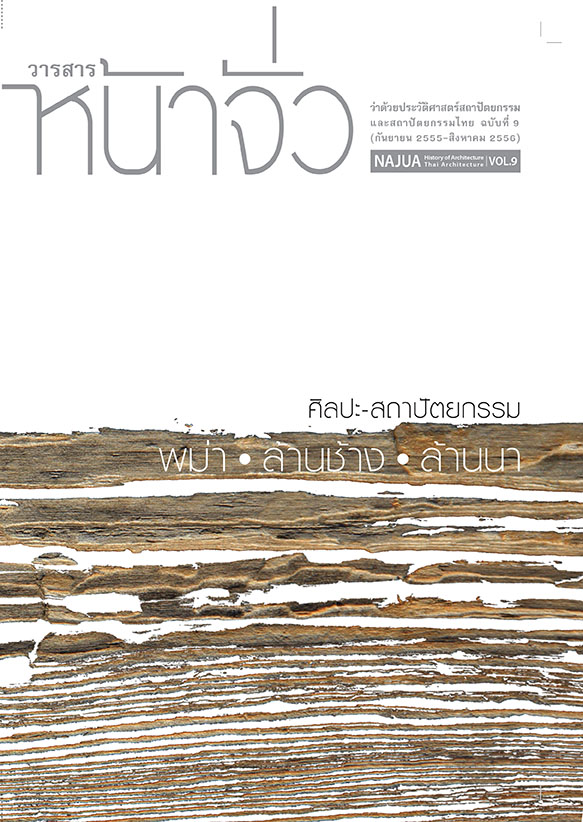ชุมชนพาณิชยกรรมเก่าวังกรด : มิติทางประวัติศาสตร์ การนิยามความหมาย และ การฟื้นฟู Wangkrot Historic District : Reinterpreting History towards Design Intervention
Main Article Content
Abstract
บทคัดย่อ
โครงการนี้เป็นโครงการวิจัยเชิงปฏิบัติการเพื่อแก้ปัญหาความซบเซาและความทรุดโทรมของชุมชนวังกรด จังหวัดพิจิตร การปฏิบัติงานเป็นการบูรณาการระหว่างงานเขียนประวัติศาสตร์ท้องถิ่น กระบวนการมีส่วนร่วม และการออกแบบเพื่อปรับสภาพการใช้งานของอาคารและพื้นที่ โดยบทความนี้จะสะท้อนถึงการใช้กิจกรรมการเขียนประวัติศาสตร์ในระดับประวัติศาสตร์การตั้งถิ่นฐาน และในระดับประวัติศาสตร์ครัวเรือนเพื่อเป็นการขับเคลื่อนกลไกการฟื้นฟูชุมชน เครื่องมือที่ใช้ในกิจกรรมการเขียนประวัติศาสตร์ดังกล่าวนี้คือ การสัมภาษณ์, การทบทวนวรรณกรรม (เอกสารเก่า) การจัดเวทีสาธารณะในการแลกเปลี่ยนประเด็นทางประวัติศาสตร์ และการจัดทำป้าย ประวัติศาสตร์ครัวเรือน ประโยชน์ที่ได้รับของกิจกรรมเกี่ยวเนื่องกับประวัติศาสตร์เหล่านี้ ในทางตรงคือการเกิดขึ้นของชุดความรู้ทางประวัติศาสตร์ และประโยชน์ที่ได้รับในทางอ้อมคือความตื่นตัวของชุมชนซึ่งเป็นพื้นฐานที่สำคัญ อันจะนำไปสู่ขั้นตอนประชาคมและการตีความประวัติศาสตร์
การเปลี่ยนสภาพชุดความรู้ทางประวัติศาสตร์ไปสู่กระบวนการฟื้นฟูระยะนำร่อง ทำโดยอาศัยการมีส่วนร่วมทั้งจากชุมชน นักวิจัย รวมถึงนักออกแบบบางส่วนจากภายนอกผ่านการประชุมกลุ่มย่อยและประชาคม เพื่อนำเสนอความเป็นไปได้ในการตีความประวัติศาสตร์ และการใช้งานอาคารใหม่ กรณีศึกษาที่ได้ยกมานำเสนอในบทความนี้ มีตัวอย่างคือ การประยุกต์พื้นที่ใต้ชายคาที่ถูกทิ้งร้างไปเป็นเป็นทางสัญจรร่วมหน้าอาคาร และการประยุกต์พื้นที่หน้าร้านที่เลิกใช้แล้วไปเป็นพื้นที่ในการจัดแสดงประวัติศาสตร์ท้องถิ่น
กิจกรรมการฟื้นฟูที่ได้จัดทำในโครงการนำร่องได้ส่งผลกระทบเชิงบวกในวงกว้างต่อชุมชน กล่าวคือ ได้เกิดการขยายผลอย่างเป็นอิสระโดยชุมชนเอง ดังเช่น การเกิดพื้นที่จัดแสดงประวัติศาสตร์ในพื้นที่ส่วนพาณิชยกรรมที่เลิกในหลายหลัง การเกิดความพยายามที่จะปรับปรุงอาคารด้วยตนโดยเคารพต่อบรรยากาศองค์รวม ในส่วนของกลุ่มทางสังคมได้เกิดการรวมกลุ่มของพ่อค้า แม่ค้าเพื่อการจัดกิจกรรมตลาดอาหารทุกวันหยุดสุดสัปดาห์
Abstract
Rehabilitation of Historic Wangkrot Market is an action research implemented and integrated toward 3 fields of practice: local historiography, public participation and building intervention. This article aims to reflect how the development mechanism emerged upon the series historically activities. Two levels of historiography are concerned on this study : the history of settlement and the historical census (history of individual). In order to conduct such historiography, various tools were employed: interview, literature review, public gathering and “poster as data presentation.” The results of this first phase are the distribution of historical framework and knowledge. Moreover, the community was indirectly stimulated and aware of their own existed values.
The series of activities related history was transposed to the planning of pilot project. The public forum and the focused group facilitated the discussion of reinterpreting historical fabric: how to re utilize the neglected historical area in nowadays circumstance. Two case studies are demonstrated here in this article : the adaptive reuse of neglected undercover area to the arcade-like space and the conversion of historic commercial space to the living museum.
The initiations of these pilot projects generate the extended positive impact to the community. There are the spontaneous initiatives by local people themselves, for instance : the emergence of private livings exhibition and the independent renovation of the houses, however, highly respect the whole integrity. The social impact could also be seen on such concurrent, there is a conceiving of merchants group as a new social organization to establish the weekend food market.

